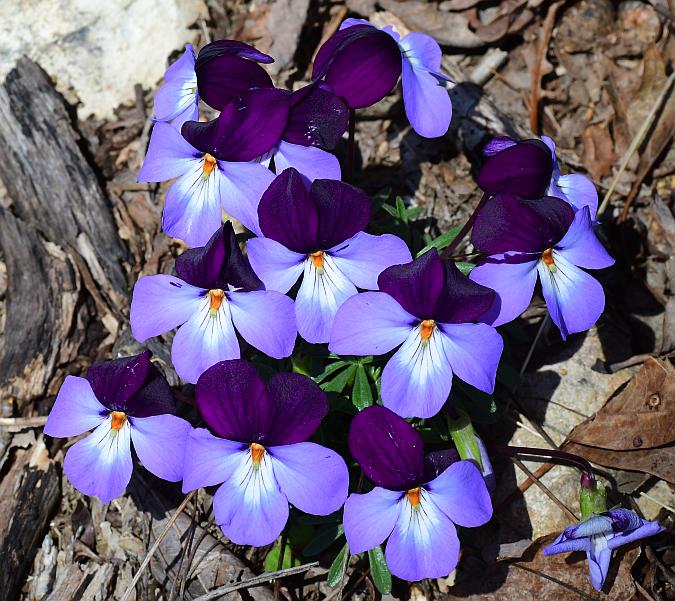Viola pedata L.
Bird's Foot Violet

Native
CC = 5
CW = 5
MOC = 75
© SRTurner
Viola pedata L.Bird's Foot Violet | |
 |
Native CC = 5 CW = 5 MOC = 75 |
© SRTurner |
|
Family - Violaceae Habit - Perennial forb to 20 cm tall, with fibrous roots and a short, erect rhizome 4-8 mm thick. Stems - Aerial stems absent. Leaves - All basal, long-petiolate, the petiole to 5 cm, with single adaxial groove, glabrous or minutely and inconspicuously hairy. Stipules conspicuous, membranous, fused to the petiole for about 2/3 of their length, lanceolate, the margins narrowly lobed or toothed, glandular-hairy. Leaf blades to 5.0 cm long, those of the outer leaves smaller, slightly longer than wide to wider than long, ovate to kidney-shaped, deeply and ternately dissected into uniformly slender, linear to oblanceolate segments 1-3 mm wide, the central segment typically undivided or with a few irregular teeth, the lateral segments ternately lobed again, the ultimate segments mostly rounded to broadly or bluntly pointed at the tips, entire or irregularly few-toothed (usually also minutely hairy) along the margins, the surfaces usually minutely hairy.
Inflorescence - Single pedunculate flowers from caudex. Flower stalks not or only slightly overtopping the leaves. Peduncles to 10 cm long, glabrous, often purplish, with pair of linear bracts at or below the middle. Bracts to 1.3 cm long, 1 mm broad.
Flowers - Sepals 9-13 mm long, lanceolate, narrowly angled to a sharply pointed tip, the margins sometimes minutely hairy, the basal auricles well-developed. Corollas 12-22 mm long, appearing strongly frontally flattened, the petals longer than the sepals, all lavender, pale blue, or bluish purple (with a white throat and sometimes greenish veins), or the upper pair conspicuously darker purple to purplish black, all glabrous (beardless) on the upper surface, the spur conspicuous, well-exserted beyond the sepal auricles, stout and often somewhat hemispheric in shape, often somewhat purplish-tinged. Stamens exserted beyond the corolla throat, the orange tips noticeable without dissection of the flower. Style glabrous, 2mm long, club-shaped with an oblique concave area near the tip. Cleistogamous flowers not produced.
Fruits - Capsules 8-13 mm long, narrowly ellipsoid to ellipsoid, green, drying to tan or olive-colored, the surface glabrous. Seeds numerous, 1.5-1.7 mm long, tan. Flowering - April - June and sometimes again in late fall. Habitat - Glades, upland prairies, savannas, openings of rocky or dry upland forests, tops of bluffs, streambanks, pastures, fields, roadsides. Origin - Native to the U.S. Lookalikes - V. pedatifida. Other info. - This striking and easily identifiable species is common across most of Missouri except for the northwestern corner of the state. It ranges throughout most of the eastern half of the continental U.S. and also into Canada. The flowers are large relative to other violets, and the leaves are finely divided and reminiscent of a bird's foot. Photographs taken somewhere in North Carolina, 4-27-03, and in the Piney Creek Wilderness, Mark Twain National Forest, Barry County, MO., 4-9-01 and 4-5-04 (DETenaglia); also at Weldon Spring Conservation Area, St. Charles County, MO, 4-13-2011, and Little Lost Creek Conservation Area, Warren County, MO, 3-30-2012, 4-25-2014, 4-8-2020, and 4-14-2021 (SRTurner). |